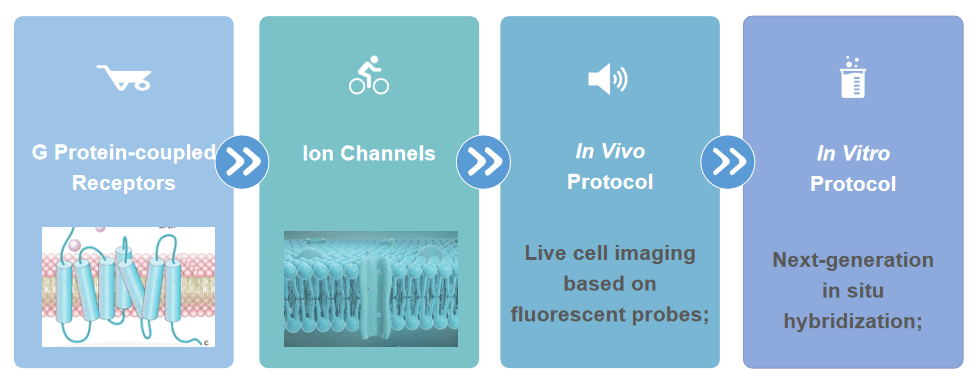Creative Bioarray has established well-established protocols for visual analysis solutions for receptors and ion channels in single cells. Our assay services can be used for the validation of targets obtained from high-throughput assays for drug discovery in the nervous system and peripheral nervous system. Our molecular testing platform is compatible with a variety of commercial probes, and we also provide probe design and customization services for personalized target testing. In addition, our comprehensive analysis method has the possibility of simultaneously analyzing the protein level of coding sequences, and the optional co-expression analysis service is your reliable choice.
Nervous System Drug Development and Channels
Substance transport by cells in the central and peripheral nervous systems is primarily associated with G protein-coupled receptors (GPCRs) and ion channels. GPCRs are the largest family of membrane receptors in humans and many other species, with 600 to 1000 members. Their endogenous ligands include odorants, hormones, neurotransmitters, chemokines, and more, ranging from photons, amines, carbohydrates, lipids, peptides, to proteins. GPCRs are associated with many normal biological and pathological conditions, such as type 2 diabetes (T2DM), depression, cancer, Alzheimer's disease. GPCRs are highly functional and recognize a wide range of ligands, including photons, small molecules, and proteins, and are considered the largest target family for approved drugs. Many factors make GPCR-targeted drugs widely available, including their druggability, interactions with various chemical entities, and expression in the plasma membrane. Ion channels, the pores in cell membranes that allow ions to pass in and out of cells, have become popular targets for drugs. There are more than 400 ion channel genes in the human genome. In situ hybridization methods such as FISH are already available for the measurement of GPCR and ion channel activity. The associated gene expression and channel activity can be tracked by in situ hybridizations of fluorescently labeled probes. For example, ion channel activity can be characterized by fluorophores that are sensitive to changes in membrane potential and ion flux.
 Fig 1. The number of GPCRs targeted by approved drugs. (Krishna Sriram, et al. 2018)
Fig 1. The number of GPCRs targeted by approved drugs. (Krishna Sriram, et al. 2018)
Visual Analysis of Membrane Channel Associations in the Nervous System
We offer solutions for analyzing the expression and activity of membrane receptors and ion channels in the nervous system. Fluorescently labeled probes enable the method to validate assay results at the single-cell level when reliable antibodies are lacking. High-throughput transcriptome analysis in the screening phase of drug development enables researchers to study the complete RNA transcripts produced by the genome, including microarrays, RNA sequencing. These methods often generate large amounts of data, and potential targets to be screened often need to be validated in cellular models or tissue microenvironments. The development of next-generation in situ hybridization and live-cell imaging methods makes validation more credible. Our platform offers customization of a variety of in situ hybridization solutions, as well as transcriptional and protein co-expression analysis capabilities, ideal for visualizing potential molecular targets within the morphological scale of the central and peripheral nervous systems.
 Fig 2. FISH solutions for ion channels and receptors.
Fig 2. FISH solutions for ion channels and receptors.
If you are interested in our FISH service, please contact us for cooperation. We look forward to cooperating with you in the near future.
Reference
- Sriram, Krishna, and Paul A. Insel. "G protein-coupled receptors as targets for approved drugs: how many targets and how many drugs?." Molecular pharmacology 93.4 (2018): 251-258.


 Fig 1. The number of GPCRs targeted by approved drugs. (Krishna Sriram, et al. 2018)
Fig 1. The number of GPCRs targeted by approved drugs. (Krishna Sriram, et al. 2018) Fig 2. FISH solutions for ion channels and receptors.
Fig 2. FISH solutions for ion channels and receptors.


